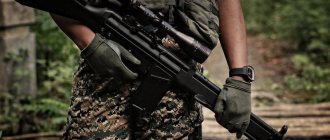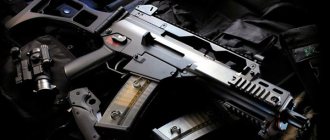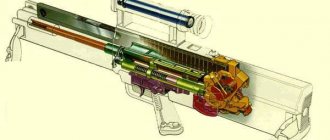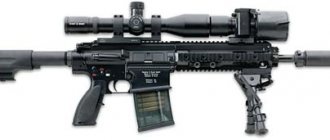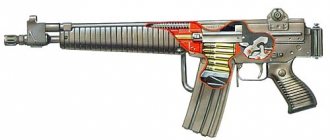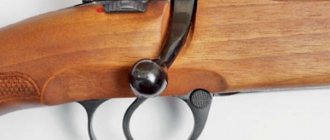In the early 90s, the German Bundeswehr carried out a reorganization of army structures with subsequent rearmament. At that time, the Heckler und Koch G3 rifle, well known in the world, was in service. To replace it, a new development by German gunsmiths was envisaged - G11. However, NATO did not approve of these changes, as it sought to unify and standardize all rifle systems and the ammunition they use. Since the new rifle used a special caseless cartridge of 4.73 mm caliber, it was decided to leave it for arming reservists, and instead develop a new weapon. This was facilitated by the reunification of the two republics - East and West Germany - in 1990, and the accompanying significant financial costs. And so a completely new weapon appeared - the German G36 assault rifle.
Reasons for rearmament and history of the creation of the rifle
These events were also accompanied by changes in NATO. The Alliance actively distributed the new 5.56 mm cartridge to the troops, which required Germany to provide weapons using this cartridge. In 1992, senior management presented the concept of a new weapon system - IDZ (Infantryman of the Future). This concept included an assault rifle and a light machine gun, which were supposed to complement the MG-3 in service. THEIR purpose was to support infantry units. And German gunsmiths actively began developing new models.
On September 1, 1993, a technical specification appeared, created by experts from the Arms Procurement Agency. After this, it became clear that all the samples that are in service with the Bundeswehr do not meet the remaining requirements. Thus, the task became even more complicated, because now all weapons had to be completely replaced, and not just one sample. When fulfilling the order, two main competitors appeared - the German company Heckler und Koch and the Austrians Steyr.
In such tense conditions, H&K managed to perform at their best. The company's designers managed to create in a very short time a simple, cheap, but at the same time reliable family of weapons - the HK.50 assault rifle and the MG.50 machine gun based on it. These samples turned out to be in many ways better than the then popular Austrian AUG 77 and the AUG/HBAR machine gun developed on its basis. The leadership liked them so much that they were soon adopted by the Bundeswehr under the designations G36 and MG36. However, in the first months of the system's existence, a relatively small number of units were produced (approximately 35,000 rifles and 200 machine guns). This was due to financial difficulties in Germany.
Design Features
What is noteworthy is that the usually pedantic Germans abandoned tradition this time. Typically, the company used the principle of operation of the automation of its weapons, based on the recoil of a semi-free bolt, while the barrel remained motionless. The locking system based on the roller shutter was also rejected. Even the Kalashnikov system, which could have become the basis for a new rifle, was rejected. To create the G36 automatic rifle, they decided to use the design of another popular weapon - the American M16.
The G36 assault rifle (automatic) consists of the following parts: a receiver (which includes a non-removable barrel, a carrying handle with a built-in optical sight), a folding stock, a trigger mechanism with a pistol grip, a magazine and magazine receiver, a forend, a movable automatic and bayonet.
Device and circuit
The automatic operation of the G36 air rifle is designed with a design that is as similar as possible to the American-made AR-18 weapon. The engine is gas-based, with a small stroke made specifically for the gas piston. There are 7 lugs on the barrel. They should all be locked up before using the rifle.
German rifle diagram
The cocking handle is located on the upper part of the box. You can independently bend it in different directions within a range of 90 degrees. This option makes the rifle suitable for both right-handers and left-handers, without creating any inconvenience.
The USP is securely screwed with pins located in the transverse direction and is made in the form of a neat block equipped with a trigger guard. The pistol grip is attached separately. A convenient flag-type translator is used as a fuse.
Some parts of the machine are made entirely of plastic. These are, in particular, a folding stock, a barrel box, and a forend.
To be able to control cartridge costs, stores are made of special transparent plastic. Additionally, convenient fastenings are provided for connecting magazines into pairs. This function is necessary to speed up the weapon reloading process.
One of the qualities of rifles is silent shooting, the Val rifle has such qualities, see photos here. The Crosman trail np 8 bt1k77wnp air rifle cannot boast of being silent, but it stands out with other qualities. These characteristics can be seen by reading the material about sniper rifles in the world.
Automation operation
The operating principle of the automation is standard - removal of powder gases from the barrel bore. In the G36, the designers implemented their own invention - a gas engine with an original design, which is made with a split bolt carrier, which now does not depend on a short-stroke gas piston. When fired, the piston acts on the bolt and moves it to the rear position. The barrel bore is locked thanks to special lugs (7 in total), while the bolt must be rotated 30 degrees using the stem. This design of the gas outlet made it possible to reduce the weight of the rifle and reduce the influence of operating automation on the stability of the weapon when firing and reducing the weight of the locking unit itself.
Features of the trigger mechanism
The trigger mechanism (trigger mechanism) is completely similar to its predecessor - G3. It is assembled in a special box, which also contains the trigger, pistol grip and guard. This increases the ease of control and firing. To secure the box to the receiver, transverse pins are used. The trigger itself is a trigger type. It is designed to conduct both single and automatic fire. The safety and fire mode selector are combined; a double-sided flag that performs this task is installed above the pistol grip, which makes it easier to switch firing modes in battle. However, the factory settings may vary - the rifle can be supplied with various combinations of modes - single-fire only, single and automatic fire, single and two-shot bursts, or with three modes at once.
Headset and performance indicators
Another design feature of the weapon is the ability to fire from both the right and left hands. The reloading handle is mounted on the top of the receiver in such a way that it can be tilted in any direction by 90 degrees. It affects the moving parts of the automation when retracted. When firing, the handle moves along with the bolt frame. Compared to the G3 rifle, many changes were made to its design that improved the functioning of the reloading system, especially in adverse conditions. At the same time, the receiver is reliably protected from contamination, since the slot for the handle to pass through has been removed. Spent cartridges are ejected through a special extraction window on the right side of the receiver. The handle for carrying the rifle, mounted on the top of the receiver immediately above the reloading handle, is also original. Thus, the center of gravity of the rifle is located just under the carrying handle. Another of its functions is the ability to aim, since the devices for this are mounted in its rear part. A distinctive feature of this rifle is a permanent three-fold scope. It is designed for a distance of approximately 800 meters and is equipped with a laser designator. In addition, there is also a standard red dot sight that allows effective shooting at a distance of up to 200 meters. The handle also allows you to mount other sights on it - for example, Zeiss released a Hensoldt AG night sight for this rifle without illumination, shooting with it is possible at a distance of up to 350 meters.
Heckler&Koch G36
Although after the Second World War, which ended ingloriously for Germany, this state led a relatively peaceful lifestyle and the Bundeswehr did not take part in wars and local conflicts, German small arms became widespread on all continents. The most popular, although not comparable to the AK and M16 systems, was the G3 automatic rifle (7.62x51 NATO). The 5.56 mm G33 automatic rifle is also well known throughout the world. Based on these samples, self-loading sniper rifles SG1 and PSG1 were developed, used mainly by special units of various law enforcement agencies.
For several decades, the Germans shone with originality, creating rifles whose automatic operation was driven by the recoil of a semi-free bolt. But in the second half of the 90s, an advertising campaign began for a new type, or rather for the G36 weapon system from Heckler&Koch. Of course, in the advertising the Germans limited themselves to general phrases about the excellent performance qualities of the design and did not say a word about the reasons that forced them to abandon the semi-free shutter and switch to a gas outlet.
A variant of the G36 light machine gun (Light Support Weapon) can be equipped with a dual drum magazine with a capacity of 100 rounds
Yes, the automation of the new rifle works precisely due to the energy of the powder gases vented through a side hole in the wall of the barrel bore. In addition, in accordance with modern trends, polymers are widely used in the design of the G36, and the system itself is built on a modular principle, which is actually why it is called a system.
Development of the G36 began in 1990 as part of Project 50. In the future, the system was to serve as the basis for the creation of not only an assault rifle and its modifications, but also a 9-mm SMG submachine gun (to replace the N&K MP5) and a single 7.62-mm GPMG machine gun.
The basic model is the G36 automatic assault rifle (G36 Assault Rifle) built according to the classical design. The receiver, fire control handle, magazine receiver, butt, forend, optical sight housing with carrying handle are made of plastic. The automatic rifle, as already mentioned, works by removing gases with a short stroke of the piston. The barrel bore is locked by turning the bolt through six lugs. The bore of the cold forged barrel is chrome plated. The trigger mechanism ensures firing in single shots and continuously. As an additional option, the manufacturer offers several trigger options with different combinations of firing modes: only single shots, bursts of 2 shots + continuous fire, single shots + bursts of 2 shots. Turning the safety on and off, as well as switching fire modes, is done using duplicate keys located on both sides of the receiver above the fire control handle.
The cocking handle can be rotated both left and right. The safety switch flags are located on both sides of the receiver above the fire control handle. All this allows you to control the weapon with equal convenience from any hand.
The rotary cocking handle, located under the carrying handle, allows it to be operated with both left and right hands. The buttstock folds onto the right side of the receiver. Thanks to the frame design, in the folded position the butt does not block the window for ejecting spent cartridges. The butt is equipped with a rubber butt pad.
Sights G36 consist of an optical sight with 3X magnification and a collimator sight mounted above it (without magnification) with a red mark. On the weapon, sighting devices are mounted together with a carrying handle. According to the developers, the 3x optical sight is designed for shooting at long distances, and the collimator is designed to provide ease of aiming when firing at rapidly appearing targets. In my opinion, this is the first time a combination of optics and collimator has been used on a serial army model. It is possible to equip the G36 with a night sight with a third-generation image intensifier tube.
The export version of the G36 family, marked with the letter “E” (G36E), uses a 1.5X optical sight as the main sight. On the top of the carrying handle are the rear sight and front sight. The non-adjustable mechanics is an auxiliary sight and ensures relatively accurate aiming of the weapon at the target only at extremely short distances.
Short version of G36 (Carbine) with folded stock
G36 cartridges are fed from box magazines with a capacity of 30 rounds. The magazines are interchangeable with M16 magazines. The magazine release button is located in front of the trigger guard. The magazine is made of transparent plastic, which allows visual control of the number of cartridges in the magazine. On the side surfaces of the magazine there are elements with the help of which two or three magazines can be connected to each other (more is possible, but it is pointless, since any manipulations with a bulky weapon will be very difficult). Using this assembly allows you to somewhat reduce the time required to replace the magazine. Unlike homemade twists with electrical tape, plaster or tape, all connected magazines are oriented with the neck up, which reduces the likelihood of dirt getting inside the magazine. Despite the originality of this approach, the design is not without its shortcomings. In particular, the weight of the loaded weapon and its width dimensions increase significantly. Therefore, the use of “triple” magazines is recommended only with the “rifle + bipod” option, used as a light machine gun or light support weapon (G36 Light Support Weapon), as this weapon is commonly called abroad.
Light machine gun G36 (Light Support Weapon) with a drum magazine with a capacity of 100 rounds. A light machine gun differs from a rifle in the presence of a folding bipod and a heavier barrel
The machine gun can also be equipped with drum magazines for 100 rounds. A light machine gun differs from a rifle not only in the presence of a folding bipod, but also in a heavier barrel, which ensures intense fire. The barrel is installed in the receiver liner using a joint and clamped with a lock nut.
It is the barrel that determines the purpose of the weapon: a standard 480 mm long barrel is intended for an automatic rifle, a heavy barrel of the same length for a light machine gun, and a 320 mm long barrel for an automatic carbine (G36 Carbine). In addition, the carbine differs from the rifle and machine gun in that it has a larger flash suppressor and a shortened fore-end. The receiver with moving parts, trigger mechanism, stock, sights, receiver and fire control handle is the same for all G36 variants. An interesting fact is that the Germans used a 6X4 type knife bayonet from a 7.622mm modernized Kalashnikov assault rifle. Most likely, the thrifty Germans were inspired to take such a step by the huge number of these bayonet knives that the Bundeswehr received during the unification of Germany.
The design of the light machine gun and rifle of the G36 system allows you to attach a 6X4 type bayonet from a 7.62 mm modernized Kalashnikov assault rifle
Using mainly foreign press materials, it is difficult to get an absolutely complete impression of the G36E system. But the available information allows us to draw some conclusions.
Firstly, it seems that the Germans have finally put an end to the long-term scam with the caseless “super rifle” G11.
Secondly, being realists and pragmatists, at the end of the 20th century they came to generally accepted principles of operation of automation and barrel bore locking - a gas outlet with a rotating bolt. In addition, the weapon is built according to a classic design (not a bullpup) with a folding butt.
Thirdly, there is a tendency to use an optical sight with a slight magnification as the main one on an assault rifle.
Fourthly, by developing a complex of a rifle, a light machine gun and a carbine with a high degree of unification of parts and components, the Germans followed the path along which domestic small arms have been developing for half a century, starting with the AK/RPK.
Our weapon system received further development in the 700s with the adoption of 5.455 mm models - AK74, RPK74 and AKS74U. In addition to them, the Russian Army is currently armed with the AK74M and RPK74M, and the 5.455 mm small-sized AK105 assault rifle is being tested. The military life of an assault rifle with a displaced recoil impulse ANN94 begins.
The Russian 5.45-mm small-sized Kalashnikov AK105 assault rifle, according to foreign classification, belongs to shortened assault rifles - carbines, and is a classmate of the G36 Carbine
The modern AK system is fundamentally different from the G36 in the absence of (as the main) optical sight and the limited use of plastic. However, the widespread use of plastics does not give the Germans a significant gain in weight on the main model - the assault rifle.
The main example of the G36 family is the assault rifle (Assault Rifle)
Using an optical sight as the main sighting device, and even more so a combination of two optical systems, does not always ensure the convenience (and even the possibility) of aiming a weapon at a target. For example, for some time now foreigners have begun to widely use illustrations in advertising their weapons, where rifles and pistols literally bathe in mud along with soldiers. I think everyone understands that using optics (and, accordingly, conducting aimed fire) immediately after a mud bath is very difficult and wiping the lenses with a dirty finger is unlikely to help. In such a situation, “mechanics” is much more reliable. Of course, this is a special case and when assessing reliability, priorities can be set in different ways. After all, in the Soviet Union, the development of a compact and simple automatic optical sight was carried out for many years, and the effectiveness of its use was proven by research and testing.
The example with optics characterizes the approach of many European countries to the reliability of weapons in combat conditions. Often, a generally reliable model, for the sake of obvious superiority in visible indicators, loses to its classmates in terms of comprehensive reliability, which makes the use of weapons difficult or impossible in equal conditions, for example, with the Russian model. The desire of developers to create a salable product is also reflected here, which leads to the advancement of modern or pseudo-modern design solutions and technologies.
Scheme of the sighting mark for the G36 optical sight. The main aiming mark (corresponding to the STP at a distance of 200 m) is the point of intersection of the vertical and horizontal threads. The diameter of the ring mark in the center of the field of view corresponds to a target height of 1.75 m at a distance of 400 m. The intersection points of the horizontal thread with the ring mark are used as aiming marks when shooting at a target moving perpendicular to the direction of shooting at a speed of 15 km/h (running people) at a distance of 200 m. The intersection of the vertical thread with the bottom of the ring forms an aiming mark for shooting at 400 m. Below are marks for distances of 600 and 800 m
In the modern automotive industry in the 90s, the concept of “parquet jeep” appeared, denoting a car with all the characteristic features of an SUV; it was intended for driving on well-maintained city highways, rather than off-road in the literal sense of the word. Moreover, the newfangled term is already perceived by customers as the norm. From such a car they expect high speed and comfort on the asphalt, and not cross-country ability and reliability in the forest.
I think that we won’t have long to wait for the introduction of a similar concept in relation to weapons that will be called combat weapons, while being panicky about the conditions of a real war. Moreover, in non-belligerent states such weapons will be perceived as the norm.
Gun lovers (including those in Russia) can purchase the civilian version of the G36 self-loading carbine SL8. The carbine can be equipped with various sights, forends and a bipod, including those with adjustable support heights
In our country, weapons of the AK family, which have gone through dozens of wars and local conflicts on all continents, will form the basis of the RA small arms complex for a very long time. Abroad, the situation is such that, despite the hype around promising combined systems consisting of an automatic rifle, a semi-automatic grenade launcher and an optoelectronic sighting system, the main models remain 5.56 mm assault rifles (5.56x45 NATO caliber). A certain prematureness of a serious conversation about fundamentally different designs is confirmed by the appearance in Germany at the very end of the twentieth century of the G36E weapon system.
Among the latest developments of foreign arms companies, two rifles attract attention: the Belgian F2000 (FN Herstal) and the Singaporean SAR 21 (VT Kinetics, Inc.).
Judging by the momentum with which the SAR 21 is being promoted at recent gun shows, Singapore is about to arm the entire world with its assault rifle. But, most likely, if SAR 21 gets any widespread use outside the country of origin, its “habitat” will be limited to the countries of Southeast Asia and some African states, whose rulers are eager for everything new.
The SAR 21 is a fairly ordinary weapon by modern standards, the only original thing being the presence of a built-in laser designator.
But the F2000 is the result of an attempt to create a promising assault rifle, significantly different from most bullpups.
The Belgian assault rifle F2000 (FN Herstal) is very similar to the weapon from the Star Wars films. In fact, this is a “bullpup” with an under-barrel grenade launcher
The rifle's optical sight can be replaced with an optoelectronic complex consisting of a laser rangefinder and an optical sight with a separate channel for an under-barrel grenade launcher. When firing a grenade, the complex operates in semi-automatic mode, issuing a command to open fire when the weapon is correctly aimed at the target.
In most bullpups, the window for ejecting the spent cartridge case is located in close proximity to the shooter’s “working” eye, and powder gases interfere with aiming during intense shooting. In addition, aimed shooting from the left hand is either completely impossible (the same SAR 21) or requires rearranging weapon parts (for example, Steyr AUG).
In the F2000, the receiver in the area of the shooter’s face does not have open holes and both of the above problems are solved by moving the spent cartridge case forward - the window is located on the right above the fore-end (in our country, such a scheme was first used in the 80s of the last century in the experimental “bullpup” I Y. Stechkina TKB-0146).
Mikhail Degtyarev
Convenience and compactness
Another distinctive feature of the German G36 automatic rifle is its exceptional compactness. Since modern troops are extremely maneuverable, they need not only effective and simple weapons, but also convenient ones. It is for this purpose that the designers introduced a folding stock into the G36 design, which reduces the overall length of the weapon from 1000 mm to 758 mm, which allows infantry to comfortably disembark from armored personnel carriers or make parachute jumps.
Repair and replacement of parts
If major repairs are required, the trigger housing must be completely disconnected. To do this, completely remove the pin responsible for its fastening.
Preparing to repair a sniper rifle
It is located in the design after the rear magazine mounting pin. The stock with the butt plate must be removed even with incomplete disassembly. To do this, pins are pulled out and screwed to the barrel box.
Read about how to repair air guns here.
Weapon power
The G36 assault rifle feeds ammunition from a magazine with a capacity of 30 rounds. It is made of transparent plastic, which allows you to monitor the consumption of cartridges; it also has special recesses on the sides that allow you to attach a spare magazine. For comfortable filling of the magazine, a clip with a capacity of 10 rounds and an adapter are made. Triple or twin magazines are used directly in combat, which increases the amount of ammunition carried by the shooter. Since the receiver is made to NATO standards, the rifle can use any magazines with 5.56 NATO ammunition.
Receiver design and features
The receiver is stamped from sheet steel. At the same time, developers are not shy about experimenting and use such innovations in production as shaped rolling, powder metallurgy or lost-wax casting. At the same time, for the production of such important parts as the trigger, butt, magazine, and receiver lining, common materials such as impact-resistant polyamide or glass fiber reinforced plastic are used.
To reduce thermal radiation during shooting, in order to camouflage the shooter from thermal imagers, all metal parts of the rifle are processed - a special heat-insulating coating is applied to them.
Disassembly and cleaning
To carry out partial disassembly of the G36 rifle, you simply need to correctly press the pins with your fingers, initiating their smooth pushing out of the grooves. The trigger body is secured to the receiver with a special pin. If incomplete disassembly is done, it can be folded forward, and after completing the necessary procedures for checking the condition of the weapon, repairing or cleaning, put it back in its original place. For information on repairing and assembling a rifle, watch the following video:
Before tilting the body, you must first separate the butt from the rear barrel box. The parts are cleaned with a special solution and then lubricated with an effective lubricant. For this model, regular cleaning and lubrication are desirable, but the G36 rifle mechanism can go for a long time without these measures.
Combat characteristics, application features
Tests carried out at training grounds and during operation showed that the rifle has high combat characteristics. Experts noted that when firing there is almost no overturning moment, the weapon is stable when firing in bursts. In particular, this result was achieved thanks to the layout. The moving parts of the automation are located above the barrel, and the stock is on the same axis with it. In addition, the sound when fired is quite quiet compared to other weapons. And the accuracy of the battle is at its best; The G36 is a rifle that, for the first time in many years, has demonstrated much higher performance than the best examples of NATO rifles. For example, when firing in short bursts (3-5 shots) at a distance of 100 m, the spread did not exceed 12 cm, along with the high survivability of the barrel (about 10,000 shots), this gives a significant advantage over the enemy. The main type of fire is automatic; as a rule, they fire in bursts of up to 5 shots, but you can also fire in long bursts (up to 10 shots), and continuously from the MG36 machine gun.
Specifications
Attention should be paid to the maximum clarity of fixation of the butt of such a weapon. The mechanical mechanism of the store is distinguished by its durability and reliability of design. The cylinder head is characterized by maximum tightness.
| Characteristics | Indicators |
| Caliber (mm) | 6 |
| Shot speed (m/s) | 115 — 130 |
| Magazine capacity | 50 |
| Weight, kg) | 2.6 |
| Size(mm) | 735 |
| Energy source | Spring, C02 |
| Bullets | Lead balls |
| Material | Plastic, metal |
| Power (J) | Up to 2 |
| Barrel type | Steel, smooth |
| Trigger type | Unregulated |
| Fuse | Manual |
| Sights | Collimator sight |
| Manufacturer | Japan |
| Approximate cost, rubles | 7200 |
H&K family
Based on this rifle, Heckler & Koch developed a whole family of weapons, which includes the MG36 machine gun, as well as the G36 K and G36 C carbines. At the same time, the German G36 rifle is a weapon that is very easy to turn into a machine gun; for this, the shooter just needs to install a heavy barrel with a bipod , and also attach to the receiver a 100-round magazine designed specifically for such cases. The peculiarity of the magazine is that it is also manufactured according to the NATO STANAG 4179 standard and its use in a machine gun turned out to be very successful.
German gunsmiths also adopted the global trend - to create many models based on the rifle (from a submachine gun to a heavy machine gun). For the Americans, the starting point was the M16, for Russia - the AK-74. Following them, the Germans began to develop other types of personal weapons. Then a niche was formed in the army, which was once occupied by submachine guns. They were designed for close-range shooting due to the low-power cartridge. As the experience of the Americans using M4 and XM177 carbines during the Vietnam War showed, troops of any country need a compact and fairly powerful weapon for combat in urban environments, as well as in the jungle, forest, etc. The Bundeswehr also needed such a model.
To solve the problem, the designers created a compact version of the G36 - a shortened rifle (carbine) with a barrel length of 318 mm. But this necessitated the use of a more powerful muzzle brake, since the recoil during a shot increased significantly. For use in special forces, the carbine can be equipped with a night sight, target designator, and tactical flashlight. The main advantage remains the ability to use the same cartridge as for the G36. Already in 1996, this family was adopted by the Bundeswehr, and their mass production was established. Export models were also developed, first designated E and later V. They were equipped with a 1.5x sight without a target designator. A little later, another model appeared - the HK G36 C, in which the carrying handle was replaced with a Picatinny rail, which made it possible to mount absolutely all sights and devices standardized by NATO on it.
Rifle modifications
- G36K is a shortened version of the weapon with a 318 mm barrel.
- G36C is an assault rifle with a Picatinny rail and a 228 mm barrel.
- G36A1 - modernized version of 2002.
- G36A2 - modernized version of 2004. A new collimator sight has appeared, as well as a handguard with a tire.
- G36KA1 and G36KA2 – shortened versions of G36A2 and G36A1 with the possibility of installing a muffler.
- G36V and G36KV are export rifles that differ only in the presence of an optical sight.
- HK MG36 is a special light machine gun based on the G36. Has a weighted barrel.
- SL-8 is a civilian self-loading rifle.
- HK SL9 is a sniper rifle chambered for 7.62×37. It is possible to install a muffler.
- The XM8 and HK416 are assault rifles based on the G36.
Video about the rifle
Combat use
The first combat use of the rifle occurred during the conflict in Kosovo, where the Bundeswehr also took part. This made it possible to test the weapon in conditions that were as similar as possible to combat, since in fact the Germans did not participate in the battles. Nevertheless, the rifle has confirmed its high combat effectiveness, maintainability, ability to operate in any conditions and reliability. The G36 series is currently used by German troops in Afghanistan, since 2001. The HK G36 rifle was also used during the conflict in Chechnya, some were captured by Russian troops as trophies.
Currently, the German G36 rifle is in service with a number of countries - Lithuania, Spain, Great Britain, US special forces, Poland, France and Albania.
Countries that have adopted the G36 rifle for service
The assault rifle as a whole turned out to be a modern weapon, excellent, reliable, accurate and convenient. In addition to Germany itself, the rifle was adopted as the main infantry weapon by the armies of Malaysia, Indonesia, Latvia, Lithuania and Spain.
The G36 rifle, as well as its modifications in general, entered service with police and army units in over 40 countries, including the UK, USA, Poland, Brazil, Thailand, Norway, Australia and so on.
The G36 has also become widespread in popular culture (computer games, cinema), including thanks to its somewhat futuristic and original design, which made it possible for it to become one of the most recognizable rifles in the world.
Airsoft and other applications
Now Heckler & Koch are actively supplying weapons to the civilian market. In particular, the SL8 model was developed for civilian use, which is designed to fire only single shots. There are also airsoft (G36 - a rifle with which airsoft becomes a fun and easy activity), hunting and sports modifications, which, like the “parent”, show exceptional characteristics and results.
Therefore, without a doubt, the G36 assault rifle is one of the high-quality weapons - it is light, reliable, convenient, highly effective in combat conditions and accurate. However, it is quite common and not secret - the G36 is a rifle, photos of which can be freely found on the Internet or in books.
Equipment for the G36 airsoft machine
The G36 airsoft machine is equipped as standard with a collimator sighting device. The presence of this element greatly facilitates the process of shooting over long distances. When purchasing, you must require a quality certificate and a warranty card, through the use of which you can easily eliminate factory defects in the weapon.
Video review of airsoft drives CYMA G36K & JING GONG G36K:
Among other things, the potential buyer is also offered a spare magazine, a battery device, a cleaning rod for cleaning weapons and a technical passport for the machine gun. Some versions of the weapons presented in this model range are equipped with a standard optical sight with 3.5x magnification.
